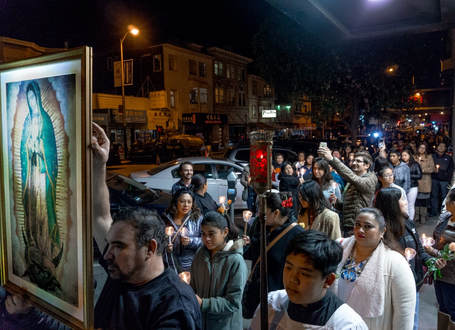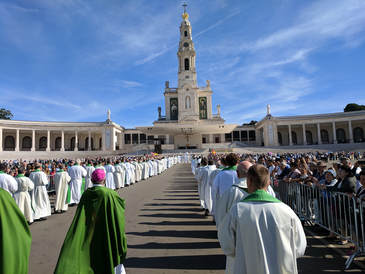Wired for Worship
We processed into the Midnight Mass this year singing Adeste Fideles, as usual. The entire church resounded with the refrain, venite adoremus: O come let us adore Him. How right it was to call out those words as we entered the church, for we humans are wired for worship, oriented toward adoration (literally in Latin “mouth to mouth”). Only adoration of “the Other” reveals us to ourselves, because only in discovering Another do we discover our own identity. “Man remains incomprehensible to himself,” St. John Paul wrote. “Only Christ the new Adam …fully reveals man to himself.” We have no identity apart from those who love us, and that relational essence of our human personhood has its source in the Holy Trinity: the eternal exchange of love between Father, Son, and Holy Spirit. Christmas marks a fundamental advance in mankind’s understanding of itself, because in peering into the face of that Baby we discover ourselves. The deepest yearning of the human person is to be at home in the Holy Family of Jesus, Mary, and Joseph, to be ‘connected’ to that Baby.
Away in a Manger
It was in the first grade that the good sisters at St. Jerome’s School in West Long Branch, New Jersey, taught me the lyrics of what is still my favorite childhood Christmas carol:
Away in a manger, no crib for a bed,
The little Lord Jesus laid down his sweet head.
The stars in the sky looked down where he lay,
The little Lord Jesus asleep in the hay.
The cattle are lowing, the baby awakes,
But little Lord Jesus no crying he makes.
I love Thee, Lord Jesus, look down from the sky
And stay by my cradle til morning is nigh.
Greccio: Francis’ tender devotion
It was St. Francis who set up the world’s first manger scene. If you drive the winding mountain roads an hour north of Rome, you will eventually see signs for “Greccio,” a little village made famous by the simple friary clinging to some limestone cliffs above the town. Something extraordinary happened there on Christmas Eve 1223. St. Francis had returned from the Holy Land some years before and wanted to bring Bethlehem to the people of his own country. In his own words, quoted from his first biographer Thomas of Celano, “I want to do something that will recall the memory of that Child who was born in Bethlehem, to see with bodily eyes the inconveniences of his infancy, how he lay in the manger, and how the ox and ass stood by.”
The Ox and Ass are important details, but more about them later. St. Francis gathered hay and wood into a little cave, built a little stable, and brought in a real ox and ass. St. Bonaventure, the great Franciscan doctor of the Church, who also lived in the Greccio Friary, recalls the scene: “The man of God stood before the manger, full of devotion and piety, bathed in tears and radiant with joy; the Holy Gospel was chanted by Francis, the Levite of Christ. Then he preached to the people around the nativity of the poor King; and being unable to utter His name for the tenderness of His love, He called Him simply the Babe of Bethlehem.”
Christmas and Easter
Cardinal Joseph Ratzinger writes about the ox and the ass in a little book called The Blessing of Christmas. Christmas, he points out, was not a liturgical feast until the fourth century. “The Church’s calendar developed initially not from the birth of Christ, but on faith in his resurrection.” It is the Easter Vigil, the mother of all vigils, that anchors our faith. Christ is portrayed in the first five centuries as a young, beardless emperor, striding in victory across the cosmos, resurrecting a dying Greco-Roman civilization. But by around 350AD, Christmas began to take its place with Easter in the calendar of feasts, for human hearts need warmth and tenderness as well as power and victory. Only after Francis of Assisi, though, does Christmas gain that special warmth we know today. “More than any other feast,” Thomas of Celano writes of St. Francis, “he celebrated Christmas with an indescribable joy…embracing with great devotion the pictures of the child Jesus and stammering words of tenderness, full of compassion, in the way children do. On his lips, the name of Jesus was as sweet as honey.”
The Vision of the Child in Greccio
So Francis set up a live manger scene for his friars and the local villagers of Greccio. They flocked to the cave, and Francis himself knelt before the manger with tender devotion. St. Bonaventure relates that a nobleman of that area, John of Greccio, “beheld an Infant marvelously beautiful, sleeping in the manger, Whom the blessed Father Francis embraced with both his arms, as if he would awake Him from sleep.” “The vision truly corresponded to what happened,” writes Thomas of Celano, “for up to that time, the child Jesus had been lying in a slumber of forgetfulness in many hearts. Through his servant Francis, the remembrance of this child was awakened and indelibly imprinted on men’s memory.”
Even unto our own day, Christmas is indelibly imprinted even in our secular cities, aptly celebrated by folks like Andy Williams as “the most wonderful time of the year.” In our restaurants and symphony halls, on our streets and airwaves, everyone is a bit warmer, more cheerful, more trusting. Before Christmas I went with friends to Handel’s Messiah at Symphony Hall. I’m always struck when 3000 people rise to their feet when the chorus proclaims a newborn child “King of Kings and Lord of Lords.” Despite our avowed secularism, manger scenes still adorn this city, because faith in God, awakened by saints like Francis of Assisi, will never quite die in the hearts of men.
Ox and Ass
But why an ox and ass? Francis was insistent that a real cow and donkey be brought into the manger scene at Greccio. “I wish to see with my bodily eyes what it meant to lie in a manger and sleep on hay, between and ox and an ass.” These animals are not mentioned in the bible, so why are they in every manger scene? We hear of them in Isaiah 1:3: “The ox knows its owner, and the ass its master’s crib….” In medieval pictures of this scene the ox and ass have almost human faces.
In some way, these animals stand in for us, who also behold the child. One must assume a simplicity of heart, a patience of soul, to become almost like a beast of burden, to understand the Incarnation. We must learn over the years to accept patiently the daily burdens of life, and to see in them the royal road to heaven, if we are to see divinity in the manger scene. The shepherds recognized divinity, but as Isaiah 1:3 continues, “The ox knows its owner, and the ass its master’s crib, but Israel does not know, my people does not understand.” Herod, the Jewish King who was to prepare his people for the Messiah, did not recognize the Christ when he came. In a blind paranoia of lust for power, he killed every male child in the vicinity in a useless attempt to kill the Messiah. It is quite difficult for the powerful—the learned masters of our age, the experts in law and governance, those of elevated social position—to see power and glory in the poor baby Jesus.
One of the miracles of Christmas, however, is that even the great ones of this world, who after all need human love like the rest of us, can come to the manger scene as well. Francis himself was from the upper middle class: educated, a knight with arms and social position, gifted with a quick wit and winning graces, whose family was among the wealthiest in Assisi. The magi were intelligent and wealthy, and Herod himself could have joined them as they made their way to adore, rather than to compete, with the divine child. It is difficult, certainly, for an independently wealthy man to gain the kingdom of heaven, harder than getting a camel through a needle. But it’s not impossible, and much easier now that God has become a child.
The Mass
And that brings us to the Mass, our own manger scene. All of us are more or less ox and ass standing gently beside the baby Jesus when we are at Mass. We take our place in the nave of the church, approaching the manger with tender devotion. You can be an unlettered shepherd—one of the invisible class here in San Francisco who run our garbage trucks before the city gets out of bed, or who clean our hotel rooms while the rest of us are out playing tourist; or you can be a highly-educated magi—a gifted member of the meritocracy, whose office on the 23rd floor is just a bit too high to notice the truck drivers and hotel employees scrambling below. Or you can be a Catholic school teacher, or a parish priest, or a small business owner. All of us can, and do, come to Mass. We stand shoulder to shoulder, beasts of burden all, before the sanctuary, which is our Bethlehem. We all feel at home in the Mass. The increasing sense of homelessness, the rising levels of anxiety particularly noticeable among our younger people, corresponds to the increasing numbers who no longer come to the family table at Bethlehem (“house of bread”). The Mass is hardly or not at all a part of their lives.
The Mass, if done well, wonderfully conveys both the intimacy and the mystery of the manger. The child comes into our arms, but the child is divine. The Most Sacred Eucharist comes into our own bodies, but remains eternal, omnipotent, Sacrament of the Lord of Lords. There are many ways the structure and traditions of the Mass accomplish this, but one initiative at my parish has marvelously brought Bethlehem closer to the people. And that is receiving Holy Communion at the altar rail. All of us come together to the wooden rail, as if to the table, to be fed. We receive at the rail, waiting to be fed by God, rather than shuffling up in a line as we do at a post office or fast food restaurant. Here is where we come, like the shepherds and the magi, rich and poor, illiterate and highly-educated, to adore him, in silence, before receiving him.
Away in a manger, no crib for a bed,
The little Lord Jesus laid down his sweet head.
Be near me, Lord Jesus, I ask Thee to stay
Close by me forever, and love me, I pray.
Bless all the dear children in thy tender care,
And take us to heaven, to live with Thee there.
Let us not be ashamed to be a “dear child,” to kneel for Holy Communion with the ox and the ass, with Mary and Joseph, and the entire cosmos of powers and dominions. May glory and worship be His forever!









 RSS Feed
RSS Feed